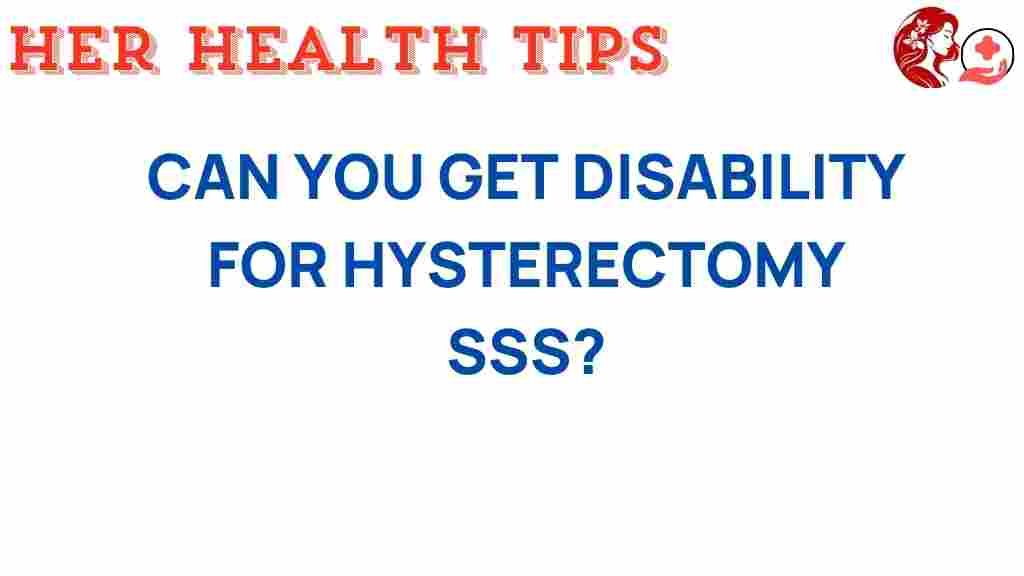Unpacking the Myths: Can Hysterectomy Qualify You for Disability Benefits?
Hysterectomy is a surgical procedure that involves the removal of a woman’s uterus, and it can have profound implications for her health and well-being. Many women undergo this surgery due to various health conditions, including fibroids, endometriosis, or cancer. However, a common concern that arises post-surgery is whether a hysterectomy can qualify one for disability benefits. In this article, we will unpack the myths surrounding hysterectomy, explore its impact on women’s health, and understand the qualifications for obtaining disability benefits, medical leave, and financial support during surgery recovery.
Understanding Hysterectomy and Its Implications
Before diving into the qualifications for disability benefits, it’s essential to understand what a hysterectomy entails and its implications on women’s health. A hysterectomy can be performed through different methods, including:
- Abdominal hysterectomy
- Vaginal hysterectomy
- Laparoscopic hysterectomy
Each method has its recovery timeline and potential complications. Post-surgery, many women experience a range of physical and emotional health conditions that can significantly affect their quality of life.
Health Conditions Related to Hysterectomy
After a hysterectomy, women may face various health conditions, which can include:
- Hormonal changes
- Chronic pain
- Mental health issues such as anxiety or depression
- Changes in sexual function
- Increased risk of other medical conditions
These health conditions can affect a woman’s ability to work and perform daily activities, which can lead to the need for medical leave or disability benefits.
Qualifications for Disability Benefits Post-Hysterectomy
When considering if a hysterectomy qualifies for disability benefits, it’s important to understand the criteria set by the Social Security Administration (SSA) and other disability programs. Here are the key qualifications:
- Medical Evidence: You must provide medical documentation that supports your claim, including surgical reports and post-operative evaluations.
- Inability to Work: You must demonstrate that your health conditions have significantly impaired your ability to perform work-related activities.
- Duration of Impairment: The SSA typically requires that the impairment last for at least 12 months.
It’s crucial to note that simply having a hysterectomy does not automatically qualify you for disability benefits. The associated health conditions post-surgery play a vital role in the evaluation process.
The Process of Applying for Disability Benefits
Applying for disability benefits can be a daunting task. Here’s a step-by-step process to help guide you through:
Step 1: Gather Medical Documentation
Collect all relevant medical records, including:
- Pre-operative assessments
- Surgical reports
- Post-operative care records
- Any treatments or therapies undertaken afterward
Step 2: Consult with Your Healthcare Provider
Your healthcare provider can help you understand your condition better and may assist in providing necessary documentation to support your claim.
Step 3: Complete the Application
You can apply for disability benefits online or at your local SSA office. Ensure all sections are filled out accurately and include all medical evidence.
Step 4: Follow Up
After submitting your application, follow up with the SSA to check the status of your claim and provide any additional information if requested.
Medical Leave and Financial Support
During your recovery from a hysterectomy, you may need medical leave from work. Understanding your rights regarding medical leave can provide you with the financial support you need. Here are some essential points to consider:
- Family and Medical Leave Act (FMLA): This federal law allows eligible employees to take up to 12 weeks of unpaid leave for serious health conditions, including recovery from surgery.
- Short-Term Disability Insurance: If you have this insurance, it may provide partial income replacement during your recovery period.
- Employer Policies: Check with your employer’s HR department about specific medical leave policies and paid time off options.
Troubleshooting Tips for Your Claim
If your claim for disability benefits is denied, here are some troubleshooting tips:
- Review the Denial Letter: Understand the reasons for denial and address them in your appeal.
- Gather Additional Evidence: More recent medical records or opinions from specialists can strengthen your case.
- Seek Legal Assistance: Consider hiring a disability attorney who can guide you through the appeals process.
Conclusion
In conclusion, while a hysterectomy can lead to various health conditions that significantly impact a woman’s ability to work, qualifying for disability benefits is not guaranteed. It requires thorough documentation, a clear understanding of the qualifications, and the ability to demonstrate how your condition affects your daily life. If you find yourself in need of financial support during surgery recovery, consider exploring your options for medical leave and disability benefits.
For more information on women’s health and disability benefits, you can visit the National Institute of Child Health and Human Development. Always consult with your healthcare provider to navigate your health conditions effectively.
Remember, you are not alone in this journey, and there are resources available to help you through your recovery and ensure you receive the support you deserve.
This article is in the category Reproductive and created by HerHealthTips Team
